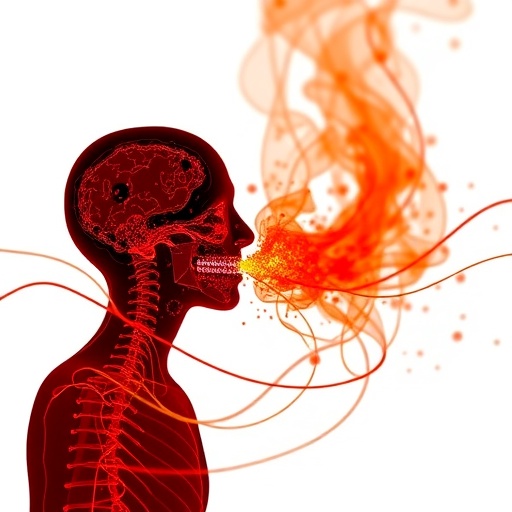In a groundbreaking study published in the latest issue of npj Parkinson’s Disease, researchers have uncovered a fascinating therapeutic avenue involving capsaicin and nicotine for the alleviation of olfactory dysfunction induced by MPTP, a well-established neurotoxin used to model Parkinson’s disease in animals. This neurodegenerative disorder is notoriously associated with profound loss of smell, a distressing symptom that often precedes the hallmark motor symptoms by years. The pioneering work unravels how these two compounds mitigate neuroinflammatory pathways, particularly by interfering with the cGAS/TBK1/STING and MAPK signaling cascades—critical drivers of immune-mediated neuronal damage.
Parkinson’s disease (PD) has traditionally been studied through its impact on motor coordination and dopaminergic neuron loss in the substantia nigra. Yet, non-motor manifestations like olfactory dysfunction, which affect nearly 90% of patients, have started to receive much-needed attention due to their critical role in early diagnosis and quality of life. The MPTP model mimics key aspects of PD neurodegeneration, offering a reliable platform to study therapeutic interventions. Here, Wei et al. employed this model to dissect molecular underpinnings of olfactory impairment, revealing the involvement of aberrant innate immune activation as a significant contributor.
Central to the study is the elucidation of the cGAS (cyclic GMP-AMP synthase) pathway, an innate immune sensor that detects cytosolic DNA and triggers downstream signaling via TBK1 (TANK-binding kinase 1) and STING (stimulator of interferon genes). This axis orchestrates a potent inflammatory response, driving neuroinflammation implicated in chronic neurodegenerative states. Using a combination of molecular assays and behavioral analyses, the investigators demonstrated that MPTP exposure hyperactivates this pathway, culminating in exacerbated olfactory neuron dysfunction. This insight positions the cGAS/TBK1/STING pathway as a novel target for mitigating early PD symptomatology.
In addition to the cGAS pathway, the study underscores the role of the MAPK (mitogen-activated protein kinase) family, another cornerstone in inflammatory signaling that modulates cellular responses to stress and injury. Aberrant MAPK activation has been previously implicated in PD pathology, but its specific contribution to olfactory deficits had been less clear. Wei et al.’s data convincingly show that MPTP induces overactivation of MAPKs, further amplifying neuroinflammatory damage in olfactory tissues. This dual-pathway involvement underscores the complexity of neuroimmune interactions in PD and suggests that effective therapies may need to concurrently target multiple inflammatory mediators.
Capsaicin, the active constituent of chili peppers known for its pungency and well-documented neuroprotective properties, emerges from this study as a potent suppressor of these deleterious pathways. Intriguingly, capsaicin administration following MPTP exposure significantly decreased activation levels of cGAS, TBK1, and STING, alongside attenuated MAPK phosphorylation. These molecular changes correlated with marked improvement in olfactory function as assessed by sensory behavioral tests. The findings propel capsaicin beyond its culinary fame and into the realm of clinical neuroscience as a promising candidate for early intervention in PD-related sensory decline.
Nicotine, widely recognized for its role in tobacco addiction but also known for neuroprotective effects in Parkinson’s disease, was similarly efficacious in dampening neuroinflammation in the olfactory system. Nicotine’s modulation of the cholinergic anti-inflammatory pathway may underlie its ability to reduce cGAS/STING and MAPK-mediated inflammatory activation observed in this work. Importantly, nicotine’s benefits extended to notable behavioral recovery of olfactory capabilities in the animal model, reinforcing the translational potential of this compound for symptomatic relief and possibly disease modification.
The study’s rigorous approach incorporated both pharmacological treatments and genetic analyses to validate the impact of these compounds on the molecular inflammatory landscape within the olfactory bulb. The authors employed immunohistochemistry and Western blotting to quantitatively measure protein expression changes, providing robust evidence of pathway modulation. Furthermore, real-time PCR data supported the reduction of pro-inflammatory cytokine mRNA transcripts following capsaicin and nicotine treatment, highlighting the broad immunomodulatory effects elicited by these naturally derived molecules.
Such findings resonate with the burgeoning appreciation of neuroinflammation as a fundamental pathogenic mechanism in Parkinson’s disease and underscore the therapeutic value of modulating innate immune pathways. The cGAS/STING axis, traditionally studied in viral immunity and cancer, is now recognized as a mediator of sterile inflammation in the nervous system—a breakthrough that could unlock new treatment paradigms for PD and other neurodegenerative disorders where inflammation fuels progression.
Moreover, this research provides a crucial link between molecular signaling pathways and functional outcomes, demonstrating that targeted suppression of cGAS/STING and MAPK not only mitigates molecular signatures of inflammation but also translates into tangible restorative effects on sensory phenotypes. The combination of behavioral assays with molecular profiling strengthens the translational relevance, hinting at feasible avenues for clinical application.
While these preliminary results in animal models hold exciting promise, the translational trajectory toward human therapies mandates cautious optimism. Variables such as dosage optimization, pharmacokinetics, potential side effects, and long-term efficacy require rigorous clinical evaluation. However, the dual therapeutic potential of capsaicin and nicotine, both with a history of human exposure and well-characterized pharmacology, could expedite the path toward experimental clinical trials targeting early non-motor symptoms of Parkinson’s disease.
The implications of this study extend even further, suggesting that early intervention aimed at neuroinflammatory circuitry might alter the disease trajectory before irreversible neurodegeneration ensues. By preserving or restoring olfactory function, it may be possible to improve patients’ quality of life and provide a biomarker for therapeutic efficacy—transforming the clinical management approach for Parkinson’s disease.
Beyond PD, the insights gained here may stimulate research into other neurodegenerative diseases where cGAS/STING-mediated neuroinflammation is increasingly recognized, such as Alzheimer’s disease, multiple sclerosis, and amyotrophic lateral sclerosis. Understanding how natural compounds like capsaicin and nicotine modulate innate immune sensors opens a new frontier in the design of neuroprotective strategies harnessing endogenous pathways.
The study also encourages a reevaluation of nicotine’s role in neurodegenerative diseases, shifting perspectives from its harmful association with smoking to its nuanced neuropharmacological effects with potential clinical utility. Similarly, capsaicin, a compound with diverse physiological actions, might be revisited for its broader neuroimmune regulatory properties beyond pain and metabolism.
Future research will undoubtedly focus on dissecting the precise molecular interactions by which capsaicin and nicotine inhibit cGAS/STING signaling and MAPK activation. Understanding these mechanisms at atomic and cellular levels could facilitate the development of even more selective agents, minimizing off-target effects and maximizing therapeutic benefits.
In conclusion, Wei et al. have illuminated a novel intersection between sensory dysfunction in Parkinson’s disease and innate immune dysregulation, presenting capsaicin and nicotine as compelling modulators of these pathogenic processes. Their work represents a significant stride toward tackling the elusive early symptoms of PD through neuroimmune interventions, opening new vistas for research, therapeutic development, and ultimately improved patient care.
Subject of Research: Neuroprotective effects of capsaicin and nicotine on MPTP-induced olfactory dysfunction through suppression of cGAS/TBK1/STING and MAPK-mediated neuroinflammation in a Parkinson’s disease model.
Article Title: Capsaicin and nicotine alleviate MPTP induced olfactory dysfunction by suppressing cGAS/TBK1/STING and MAPK mediated neuroinflammation.
Article References:
Wei, J., Wang, L., Wang, D. et al. Capsaicin and nicotine alleviate MPTP induced olfactory dysfunction by suppressing cGAS/TBK1/STING and MAPK mediated neuroinflammation. npj Parkinsons Dis. 11, 285 (2025). https://doi.org/10.1038/s41531-025-01135-4
Image Credits: AI Generated
Tags: capsaicin therapy for olfactory dysfunctioncGAS/TBK1/STING signaling in neurodegenerationearly diagnosis of Parkinson’s Diseaseimmune-mediated neuronal damageMAPK signaling pathways in neuroinflammationMPTP model of Parkinson’s diseaseneuroinflammatory pathways in PDneurotoxin-induced olfactory impairmentnicotine effects on neuroinflammationnon-motor symptoms of Parkinson’s diseaseolfactory dysfunction and Parkinson’s diseasetherapeutic interventions for neurodegeneration





